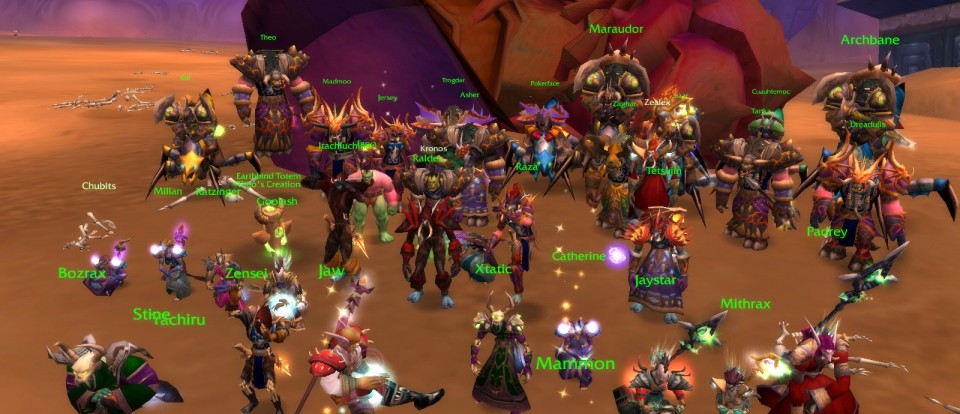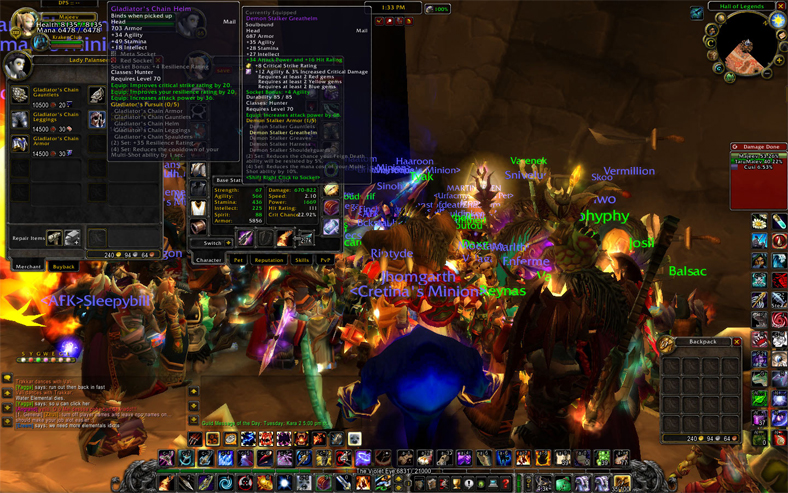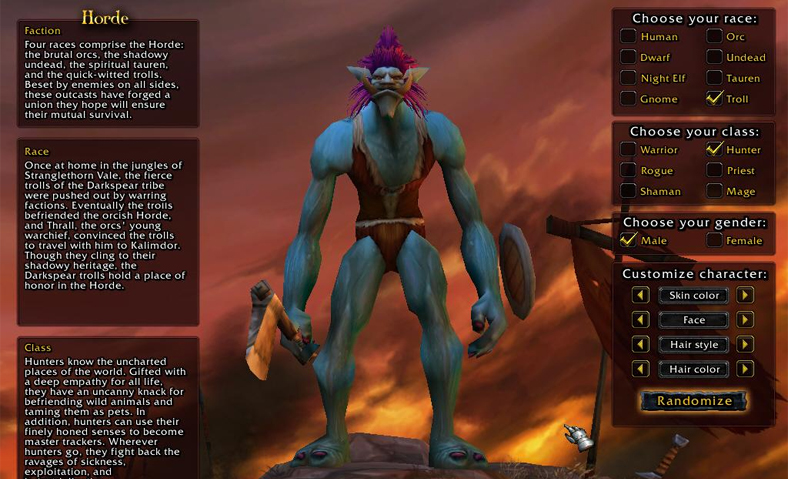
Warcrack for the Hordes: Why Warcraft Pwns the World
The paradoxical combinations of WOW.
LINKS AND DOWNLOADS
DATE
2011CONTEXT
MEDIUM
PEOPLE
“First there are the utopias. Utopias are sites with no real place. They are sites that have a general relation of direct or inverted analogy with the real space of Society. They present society itself in a perfected form, or else society turned upside down, but in any case these utopias are fundamentally unreal spaces. There are also, probably in every culture, in every civilization, real places – places that do exist and that are formed in the very founding of society – which are something like counter-sites, a kind of effectively enacted utopia in which the real sites, all the other real sites that can be found within the culture, are simultaneously represented, contested, and inverted. Places of this kind are outside of all places, even though it may be possible to indicate their location in reality. Because these places are absolutely different from all the sites that they reflect and speak about, I shall call them, by way of contrast to utopias, heterotopias.” ((Michel Foucault, “Of Other Spaces (1967), Heterotopias,” http://www.foucault.info/documents/heteroTopia/foucault.heteroTopia.en.html))
Fantasy themed, text-based, Multi-User Dungeons (MUDs) have been around since the late 1970s, but in 1997, the addition of real-time graphics and the mainstreaming of the internet allowed Ultima Online to become the first major commercial success of the Massively Multiplayer Online Role Playing Game (MMORPG, MMOG, MMO) genre.
World of Warcraft, released in November 2004, was preceded by a litany of 3-D sword and sorcery MMOs dating back to 1996, including Meridian 59, Everquest, Asheron’s Call, Shadowbane, Dark Age of Camelot, Phantasy Star Online, Final Fantasy XI, Asheron’s Call II, Ragnarok Online, and Everquest II . More recently a series of big budget online fantasy games have been released to great fanfare, including Vanguard, Hellgate London, Age of Conan, and most recently Warhammer Online.
But none of these “post WoW” games has been able to hit the mainstream nerve the way WoW has with its 11 million-plus player base and pop-cultural prominence. The common wisdom you will often hear about WoW’s massive appeal is that Blizzard simply just “got it right.” “A fundamentally well designed and executed game at the base level. WoW just feels right when you play it, something that we didn’t really have in the MMOG genre prior.” Or, “Why is it so popular? It’s easy. That’s about as simple as it gets.” ((http://hgamer.blogspot.com/2007/09/why-is-world-of-warcraft-so-popular.html))
Truedat…but is there something more about World of Warcraft that has made it the best selling MMO ever and allowed it to redefine the position of online role-playing games in the cultural landscape, from what was previously a gamer geek subculture to a mainstream cultural phenomenon? Maybe.
World of Warcraft is a Heterotopia.
The term was coined by Michael Foucault in his 1967 lecture titled “Of Other Spaces,” and fits World of Warcraft like a Furious Gladiator’s Mooncloth Glove. Foucault writes: “The heterotopia is capable of juxtaposing in a single real place several spaces, several sites that are in themselves incompatible.” ((Foucault.)) WoW allows for a multitude of permutations and paradoxical combinations in its gameplay and narrative structures that do exactly this to manifest it as a unique game in its genre.
The most significant change that WoW brought to the fantasy MMO genre was the Alliance/Horde player faction division. Warring factions are not new to MMOs. Neither is the division of the world into “good” and “evil” races. Yet what WoW has done with its faction-centered dichotomy is fundamentally different. Playing the Alliance faction “races” in WoW — Humans, Elves, Dwarves, and their friends — affords the player not only an identification with the heroic archetypes belonging to the traditional high fantasy genre, but an advertent alignment as a stereotypical member of the fantasy role playing game community, what some might call a “classic geek gamer.” By introducing the Horde as a gang of playable races that includes the thuggish Orcs, the Rastafarian Trolls, and the cannibalistic Forsaken, WoW has transformed the familiar offering of “evil” into something much more radical – the Horde are the “other.”
Earlier MMOs such as Everquest offered a small selection of playable “evil” races such as Dark Elves or Trolls. Choosing these races allowed players to play against the common “heroic” grain, but as Everquest was a collaborative game, players of these races routinely blended in and teamed up with the good races, nullifying any non-cosmetic difference between the races. WoW’s Horde, who cannot communicate with the Alliance, exist on the periphery of the fantasy world’s diegesis. Their inclusion as active agents feels alien to the genre. WOW offers players an opportunity to participate in the fantasy of World of Warcraft without buying into its narrative core. Horde play as interlopers, outsiders who are here to crash the party, who seemingly play the same game but do so in a subversive and ironic way. The Horde defines the unique culture of World of Warcraft while simultaneously occupying its counterculture. By allowing players the choice of experiencing the game sincerely as members of the Alliance or ironically as the Horde, WoW lets us have our cake and eat it too.
In his often-cited 1996 essay “Hearts, Clubs, Diamonds, Spades: Players Who Suit MUDs,” Richard Bartle presents a taxonomy of player motivations in multi-user games. Bartle divides players into the following categories: Achievers, who “regard points gathering and rising in levels as their main goal,” Explorers, who “delight in having the game expose its internal machinations to them,” Socialisers, who “are interested in people, and what they have to say,” and Killers, who “get their kicks from imposing themselves on others.” ((Richard Bartle, “Hearts, Clubs, Diamonds, Spades: Players Who Suit MUDs”, 1986, http://www.mud.co.uk/richard/hcds.htm)) In general, MMO designers have been wise to try to accommodate all four player archetypes and their various permutations.
At first, as was the case with Ultima Online, game designers tried to create a “realistic” simulation of society—allowing for the coexistence of players who wish to kill other players for fun with players who had no such motivations. The experiment proved to be too big a challenge, as killers ruined the experience of non-killers and Ultima Online became a utopia for killers and a dystopia for the rest of the population. The eventual solution, introduced in Everquest and epitomized in World of Warcraft, is to divide the player population into separate versions of the game played on different servers: Player vs. Player servers for the Killers and Player vs. Environment servers for the rest. By offering a selection of parallel game worlds identical in all ways except for their social rules of engagement tailored to accommodate opposing worldviews, WoW offers players the choice between one utopia and another.
Most gamers who strongly identify with the more aggressive and competitive First Person Shooter (FPS) and Real Time Strategy (RTS) genres—hardcore Counterstrike or Starcraft players—avoid and stigmatize the congenial fantasy Role Playing Game (RPG) genre. World of Warcraft provides an opening for such players through the kind of counterplay offered by Player vs. Player servers and by identifying with the Horde and keeps them playing by offering game experiences that mimic the FPS and RTS genres’ core game mechanics.
WoW is structured as a multi-genre game—a game that contains within its framework a diverse variety of game experiences. Players looking for standard RPG experiences — such as detailed game-lore, a narrative back story, monster slaying, dungeon crawling, character development, and loot collecting — may spend their time completing quests on their own, or with real-life friends or family, random strangers, long-term in-game acquaintances, or fellow guild members. Players can scratch their RTS and FPS itches by engaging in strategically complex Player vs. Player group battles, both in staged arenas or in open-ended planned encounters. Ranked Arena PVP seasons offer an even more acutely competitive context for the same sorts of gameplay dynamics offered by RTS and FPS tournaments. This wide range of gameplay experiences allows WoW to function more like a closed circuit television network with its own selection of internal channels to choose from.
Tom Shippey, in his writing on J.R.R Tolkien’s work, points to the variety of main characters in The Lord of the Rings as a key contributing factor to the book’s unprecedented mass appeal. For his analysis, Shippey uses Northrop Frye’s framework of literary modes. In summary, Frye’s model divides narrative into five hierarchical categories with myth at the top, followed by romance, high mimesis (tragedy or epic narratives), low mimesis (the classical novel), and finally, irony. Shippey identifies The Lord of The Rings as belonging to all five categories at once. He maps the main characters from the book as follows: Samwise as irony, Frodo and the other hobbits as low mimesis, humans as high mimesis, the Elves and Dwarves as figures of romance, and finally Gandalf, Bombadil, and Sauron as belonging to the realm of myth. He also points to the way Tolkien navigates these modes: “The flexibility with which Tolkien moves between the modes is a major cause for the success of The Lord of the Rings. It is at once ambitious (much more so than novels are allowed to be) and insidious (getting under the guard of the modern reader, trained to reject, or to ironize, the assumptions of tragedy or epic).” ((Tom Shippey, J.R.R. Tolkien, Author of the Century, Princeton 2000, p 223.))
A similar process is at work in World of Warcraft. Looking again at the choices of race that players can choose from in WoW, and considering that even within the counter-cultural frame of the Horde there are modes of engagement that develop beyond an initial irony in relation to the high fantasy genre, I would categorize the choices in the following way: Forsaken, Gnomes and female Dwarves as irony, Taurens, Orcs, Draenai, Dark Elves, Trolls, and Dwarves as low mimesis, Humans, Elves, and Forsaken (again) as high mimesis or romance. The specific placement of playable races using this model is subjective to each player, but WoW offers players a choice of how they prefer to identify their relationship to the narrative experience of the game world through the choice of character. The stratification of WoW’s literary modes as a consequence of character race is brought to the foreground when players have more than one character they can play. The race of the active character often mirrors the player’s current mood. Want to create an earnest alter ego? Likely you will not choose a female dwarf for the task, but when creating an alternative character used for casually chit-chatting in town, picking a female dwarf character for your roster does come in handy.
Even the more concrete design elements serve WoW’s appeal to a wide range of players and player emotions. The art styling is extremely bold, even expressionistic, all the while hedging the ironic against the sublime. The overall effect is uncanny. The blocky, low polygon character models and colorful pixelated textures are comically exaggerated. The animations are smooth, yet childishly cartoonish or grotesque. The outdoor environments are vividly colorized and ever flowing. The game is littered with in-jokes and pop cultural references to books, movies, celebrities, games, and other real world paraphernalia. The dialogue is overtly goofy and self-deprecating. The sound effects are deft. The music goes hand in hand with the environments to mesmerize the player, the score is epic, and while the compositions may be high fantasy clichés, they do not engage the player cerebrally the way the character models, animations, and dialogue do. It is as if WoW’s world craft is calibrated to swallow you up in its synthetic world and just as you are on the brink of total immersion, it spits you out. And then sucks you back in again.
World of Warcraft exists within a nexus of game related contexts, sometimes referred to as the Meta-game, the extra-diegetic game world, or simply the WoW community. This context includes personal fan sites and blogs, guild home pages, official and nonofficial discussion forums, game databases, strategy guides, encyclopedias, player ranking lists, sites that offer game add-ons and modifications, portals of fan-made films, and game-related news sites. The cultural artifacts generated in the Meta-game: guides, tricks, rants, treasure maps, walkthroughs, helper applications as well as fan created stories, comics, and films are openly fed back to the in-game experience. Nick Yee, who uses polling and statistical analysis to examine MMO player behavior, reports, “the average player spends about 10.8 hours each week performing game-related tasks outside of the game. . . . players spent on average 23.4 hours each week in the game. Thus, on average, the majority of players spend about an additional 50% of their game-playing time outside of the game performing game-related activities.” ((Nick Yee, “Time Spent in the Meta-Game”, from “The Daedalus Project”, http://www.nickyee.com/daedalus/archives/001535.php))
WoW is perhaps the first online role-playing game to truly function in tune with the internet generation, where a more hermetic idea of “fantasy” as a cordoned-off reality of hardcore role playing has been consciously replaced by a porous pseudo-fantasy game. The illusion has been shattered long ago, bearded paladins are swapping Chuck Norris jokes, Dark Elves are doing the Napoleon Dynamite, and Undead Warlocks are talking Pakistan in Orgrimmar, while everyone else is doing their best Leeroy Jenkins impersonation. WoW coolly embraces the Meta-game and paradoxically, by letting its guard down and allowing bits of reality to slip in and out of its fantasy world, has become the most compelling and immersive game ever.
“In the mirror, I see myself there where I am not, in an unreal, virtual space that opens up behind the surface; I am over there, there where I am not, a sort of shadow that gives my own visibility to myself, that enables me to see myself there where I am absent: such is the utopia of the mirror. But it is also a heterotopia in so far as the mirror does exist in reality, where it exerts a sort of counteraction on the position that I occupy.” ((Foucault.))


